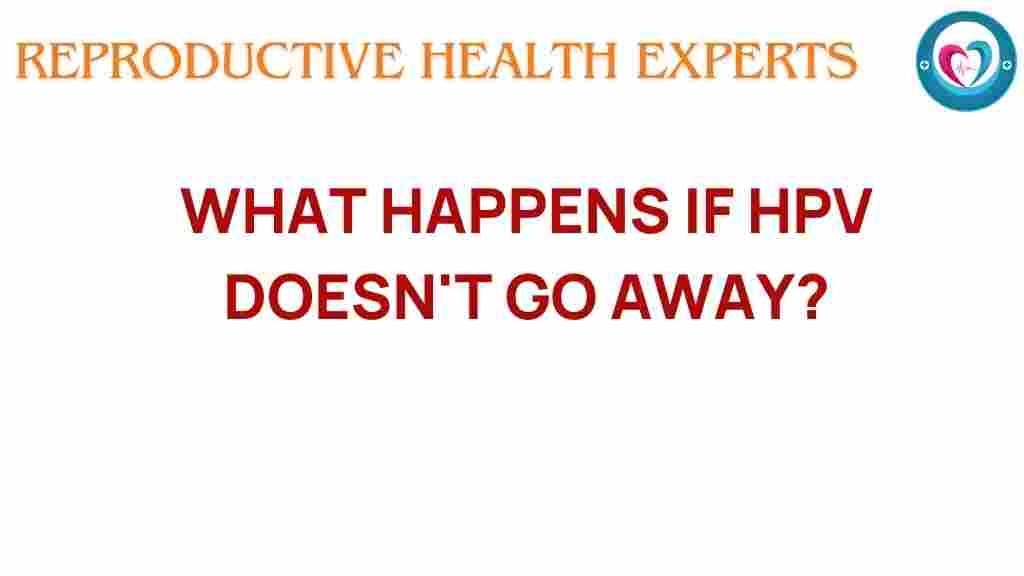The Silent Threat: What Happens If HPV Persists?
The human papillomavirus (HPV) is one of the most common sexually transmitted infections worldwide. While many people may clear the virus from their system without any treatment, persistent HPV can lead to serious health complications, including cervical cancer. Understanding HPV, its risks, prevention strategies, and treatment options is crucial for maintaining sexual health. In this article, we will delve into the implications of persistent HPV, symptoms to watch for, and the importance of vaccination and awareness.
Understanding HPV and Its Health Risks
HPV is categorized into low-risk and high-risk types. Low-risk types can cause genital warts, while high-risk types are associated with various cancers, including:
- Cervical cancer
- Anal cancer
- Throat cancer
- Penile cancer
When HPV persists in the body, especially the high-risk strains, the chances of developing these cancers significantly increase. In fact, persistent infection with high-risk HPV types is responsible for nearly all cases of cervical cancer.
Symptoms of HPV
One of the challenging aspects of HPV is that many individuals do not exhibit any symptoms. In fact, most people with HPV do not know they are infected. However, some symptoms may include:
- Genital warts (for low-risk HPV types)
- Changes in cervical cells detected through Pap tests
- Unusual bleeding or discharge (in advanced cases)
Regular screening is essential, as cervical cancer may not show noticeable symptoms until it has progressed significantly.
The Link Between HPV and Cervical Cancer
Persistent infection with high-risk HPV types is the most significant risk factor for cervical cancer. The virus can cause cellular changes in the cervix, leading to precancerous lesions and, eventually, invasive cancer if left untreated. The progression from HPV infection to cervical cancer can take many years, which is why routine screening is vital.
Prevention of HPV
Preventing HPV infection is crucial for reducing the risk of cervical cancer and other HPV-related health issues. Here are some effective strategies for prevention:
- Vaccination: The HPV vaccine is highly effective in preventing infection from the most dangerous strains of HPV. It is recommended for preteens, but can be administered up to the age of 45.
- Regular Screening: Women should undergo Pap smears and HPV testing as recommended by their healthcare provider to detect any changes in cervical cells early.
- Safe Sex Practices: Using condoms and dental dams can reduce the risk of HPV transmission, even though they do not provide complete protection.
- Awareness and Education: Understanding HPV and its risks can empower individuals to make informed choices about their sexual health.
The Importance of Vaccination
The HPV vaccine is a critical tool in the fight against HPV-related diseases. Here are some important points about the vaccine:
- Effectiveness: The vaccine can prevent the majority of cervical cancers and other HPV-related diseases if given before the onset of sexual activity.
- Safety: Extensive research has shown that the HPV vaccine is safe and effective, with minimal side effects.
- Accessibility: The vaccine is often available through healthcare providers, schools, and public health clinics.
For more information on the HPV vaccine and eligibility, visit the CDC HPV vaccination page.
Treatment Options for HPV and Related Conditions
While there is no cure for HPV itself, there are several treatment options available for managing the symptoms and health risks associated with the virus:
- Monitoring: Many HPV infections resolve on their own, so doctors may recommend regular monitoring.
- Treatment for Genital Warts: Medications, cryotherapy, or surgical options may be used to remove warts caused by low-risk HPV types.
- Management of Precancerous Changes: If screenings reveal abnormal cervical cells, procedures such as LEEP (Loop Electrosurgical Excision Procedure) may be necessary to prevent the progression to cancer.
Consulting a healthcare provider regularly is essential for managing health risks associated with HPV.
A Step-by-Step Approach to HPV Awareness
Promoting awareness about HPV is vital for prevention and early detection. Here’s a step-by-step approach:
- Educate Yourself: Learn about HPV, its risks, and health implications. Understanding the virus is the first step towards prevention.
- Talk to Your Partner: Open discussions about sexual health and HPV can help reduce stigma and promote safe practices.
- Get Vaccinated: Ensure you and your loved ones receive the HPV vaccine, especially before becoming sexually active.
- Schedule Regular Screenings: Women should have Pap tests as advised by their healthcare provider to catch any precancerous changes early.
- Share Information: Spread the word about HPV and its risks within your community to promote awareness.
Troubleshooting Common Concerns About HPV
Many individuals have concerns regarding HPV. Here are some common issues and how to address them:
- What if I test positive for HPV? A positive HPV test does not mean you have cancer. It indicates that you have the virus, and your doctor will discuss monitoring and treatment options.
- Can HPV be transmitted even if there are no visible symptoms? Yes, HPV can be transmitted even when an infected person has no symptoms. This is why safe sex practices are essential.
- How often should I get screened for cervical cancer? Women aged 21-29 should have a Pap test every three years. Those aged 30-65 should have a Pap test combined with HPV testing every five years or a Pap test alone every three years, based on risk factors.
Conclusion: The Importance of Awareness and Prevention
HPV is a silent threat that can lead to serious health risks, including cervical cancer. Understanding the implications of persistent HPV, recognizing symptoms, and taking proactive measures through vaccination and regular screenings are essential steps in protecting sexual health.
By promoting awareness and encouraging safe practices, we can significantly reduce the incidence of HPV-related diseases. Remember, taking charge of your sexual health and being informed is the best defense against HPV and its potential consequences.
For more information on HPV and cervical cancer, visit the American Cancer Society.
This article is in the category Conditions and created by ReproductiveHealthExperts Team
